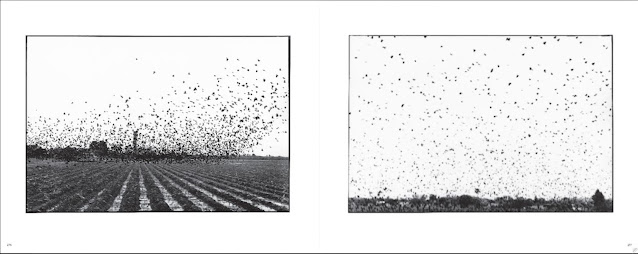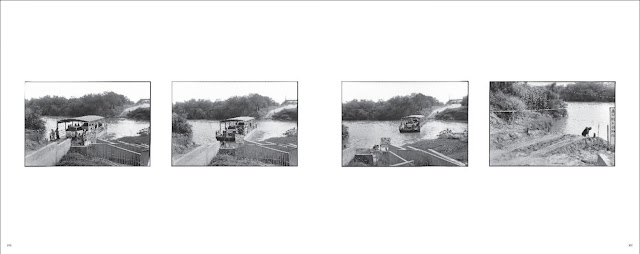 |
Al Rio / To the River. By Zoe Leonard.
|
Photographs by Zoe Leonard
Hatje Cantz/MUDAM, Luxembourg, Belgium, Luxembough, 2021. 592 pp., 350 color illustrations, 9x11".
Zoe Leonard’s two-volume project, To the River, opens with a sequence of color photographs of the turbulent surface of the Río Bravo/Rio Grande. Air bubbles mark its current, yet the river impersonates flesh with its corpulent folds. The close-range framing of its waters, eliminating all contextual information of place, feels both intimate and immense. Waters that can carry a body and consume one. The book catalogs a selection of the project’s approximately 500 gelatin silver prints and fifty C-prints. Produced over four years, Leonard followed and recorded the river’s course with attention to the tributaries of geological, historical, and imperial time. To The River’s second volume, edited by Tim Johnson, assembles writings from artists, poets, and scholars on the river’s history, borderland culture and environmental issues — companion texts that flow alongside and through Leonard’s archive.
The river is designated the Rio Grande in the U.S., meaning ‘big river’ while in Mexico, it’s known as Río Bravo, ‘wild river,’ a name evoking its temperament. This ancient, unruly waterway was taken as a border during the U.S.’s geopolitical expansion in the 19th century and remains a weaponized site of the political debates around immigration policy. Leonard’s photographs quietly trace the river’s approximate 1,900-mile length through an array of terrains. She zooms in on foliage then pulls back — landscapes and horizon lines materialize. Highways line the river and bridges cross it. The river fills the frame then is dwarfed by mountains. Its entropic force is corralled by engineering, narrowed and redirected through concrete beds that transform it into a trickle. Floods. Along its banks, I see farms, development, homeless encampments. On the ground, she gazes up at birds in the sky. And helicopters. Surveying topography and traffic from above, she inhabits the perspective of the drone.
 |
Everywhere: the architecture of the border. Chain link fences give way to monumental walls and their on-going construction. Leonard soberly documents these violent barricades. In a suite of three images, its vertical pylons are echoed in a white picket fence in the foreground. A sign strung up on its façade, WE BUILD THE WALL, announcing the organization that solicited millions of dollars to build private sections of the Trump Wall. (Its founder, Brian Kolfage, was convicted of fraud. Steve Bannon, its Advisory Board Chair, was pardoned by Trump.)
These landscapes yield evidence of its human history, although figures are rarely depicted. There are tangles of barbed wire torn down like bodies lying prostrate on the ground, lines of tire tracks in the dust, the remnants of the border patrol. Humble memorials to the people who died crossing the border. When bodies do appear, they are typically at a distance. There’s an understanding of their place in the environment and formal reserve decisively refuses the racist idioms of immigration reporting. A family swimming in the river is a reminder that the river is also a site of play and community. This is a living document — paradoxically, a voluminous snapshot of faceted time. Often, Leonard works in sequences to track the movements of water, humans, and the state. I see an affection for 19th century photography in these sequences — the desire to see clearly, born of a belief in photography’s power of witness.
 |
 |
Leonard attends to her subject with care — all that the river touches is a detail to behold. There’s cumulative precision in this lyrical atlas, slow knowledge that takes the river’s history as a guide. To The River’s politics are as much felt as declared. Leonard subverts the single lens reflex camera’s association with the iconic to produce an expansive and embodied space of witness. There’s urgency and humility in the work, eschewing the deadlock of Democratic-Republican debate, that invites the reader to consider geologic time alongside the human impact of the border crisis.
Purchase Book
Read More Book Reviews
 |
 |
 |
Laura Larson is a photographer, writer, and teacher based in Columbus, OH. She's exhibited her work extensively, at such venues as Art in General, Bronx Museum of the Arts, Centre Pompidou, Columbus Museum of Art, Metropolitan Museum of Art, Museum of Fine Arts, Houston, SFCamerawork, and Wexner Center for the Arts and is held in the collections of Allen Memorial Art Museum, Deutsche Bank, Margulies Collection, Metropolitan Museum of Art, Microsoft, Museum of Fine Arts, Houston, New York Public Library, and Whitney Museum of American Art. Hidden Mother (Saint Lucy Books, 2017), her first book, was shortlisted for the Aperture-Paris Photo First Photo Book Prize. Larson is currently at work on a new book, City of Incurable Women (forthcoming from Saint Lucy Books) and a collaborative book with writer Christine Hume, All the Women I Know.









